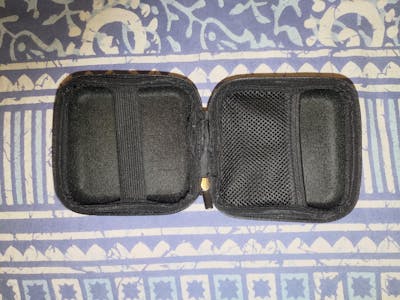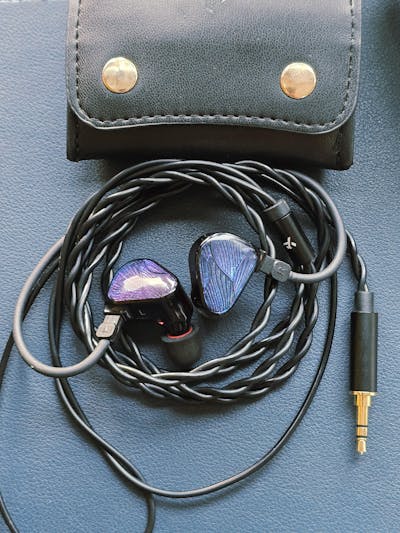Introduction-
MUSE HiFi, a relatively new brand, introduces its first Bluetooth DAC and Amplifier, the M4. Having previously launched IEMs and portable DAC & Amplifiers, the M4 stands out with its dual ES9038Q2M DAC chipset. Supporting Hi-Res PCM (32-bit/384kHz) and Native DSD256 signal decoding, this device also boasts Bluetooth 5.1 with AAC/SBC/aptX/aptX LL/aptX Adaptive/aptX codecs. Offering 2.5mm/3.5mm/4.4mm audio outputs and dual Type-C ports (one for data and one for charging), the MUSE HiFi M4 is ready for a detailed review.

Design, Build Quality & Function buttons-
The outer appearance of the MUSE HiFi M4 exudes modernity and class. The clear glass surface reveals the inner components, including the PCBA, chipsets, and ICs. Notable features include Bluetooth LED indicators, gain indicator LEDs, and an array of function buttons. The left side hosts the power on-off button, low-high gain button, and a sampling rate LED indicator for wired mode. On the same side, you'll find previous-next buttons, volume up/mute (long press), and volume down/filter mode (long press). The top features audio outputs of 2.5mm/3.5mm/4.4mm and a microphone, while the bottom houses two Type-C outputs for data input and charging. The backside is equipped with an NFC chip and black-colored glass.
Although slightly larger than comparable portable DACs & amplifiers like Questyle M15, FiiO BTR15, and Hiby FC4, the M4 remains easy to carry in a pocket or hand, thanks to its lightweight design. While sturdy, the device might be prone to glass damage if dropped. A protective case is recommended, either included in the box or sold separately by MUSE HiFi.
The tactile buttons are covered by a metal casing, ensuring a premium feel. The Type-C input ports are of standard quality, as are the output audio ports.
In the package, MUSE provides a Type-C to USB cable for charging. It would be beneficial for users if MUSE considers including Type-C to Type-C cables, enabling compatibility with smartphones or laptops.

Sound Quality-
For testing the MUSE HiFi M4, I utilized my updated iPhone 12 and MacBook Air as sources. The M4 was put through its paces with a variety of headphones, including the Sennheiser IE 200, Symphonium Meteor, ThieAudio Hype 2, Sennheiser HD 650, and HiFiMAN Sundara.
The M4 impresses as a clean-sounding wireless portable DAC & Amplifier, delivering a natural sound tonality. The bass is controlled, providing a rumbling presence without overpowering the overall audio. The midrange is slightly forward and clear, displaying a textured quality. The treble is detailed, energetic, and musical, contributing to an open and wider soundstage.
The MUSE HiFi M4 exhibits varied reactions with different types of drivers, as explored in the following sections with various IEMs:
Sennheiser IE 200:
Testing with the M4 enhances the IE 200, introducing more energy to the midrange and treble sections. The bass remains controlled without merging into other frequencies. The soundstage and imaging improve, maintaining a smooth and non-harsh output.
Symphonium Meteor:
The M4 delivers a clean, clear, detailed, and energetic output with the Meteor. Tight and controlled bass, a slightly forward midrange, and clean, detailed, and musical treble characterize the sound. The wide soundstage and precise imaging are noteworthy, with only occasional hints of a metallic flavor in certain tracks.
ThieAudio Hype 2:
The M4 successfully drives the Hype 2, rendering powerful and rumbly bass, emotional and intimate midrange, and clear, musical, and holographic treble.
Sennheiser HD 650 & HiFiMAN Sundara:
Testing these power-hungry headphones demonstrates that the M4 provides sufficient volume, making it a viable option for users who want to use headphones while traveling. The sound quality, while loud enough, is deemed average compared to a desktop setup.
All impressions are derived from wireless mode testing. In wired mode, the sound becomes fuller and slightly thicker, accompanied by a sample rate LED indicator on the M4.
While using a Type-C to Type-C cable in wired mode, I encountered challenges finding a compatible cable. The Audiocular OTG cable worked with my MacBook but not with my Android smartphone. Attempts with a Type-C to Lightning cable resulted in an iPhone popup indicating excessive power requirements. Testing Apple's provided sound filters yielded minor output changes, making differentiation challenging.
In conclusion, the MUSE HiFi M4 offers impressive sound quality, particularly in wireless mode. While wired mode enhances the depth of the sound, users may face challenges with cable compatibility, requiring careful consideration of device compatibility and available cable options.

Pros and Cons-
| Pros | Cons |
| Detailed & energetic sound | No provided carry case |
| Multiple output options | Type-C to Type-C cable not included |
| Separate charging and input ports | Fingerprint magnet |
| Transparent, modern design | Light impact of provided filters |
| Stable Bluetooth connection | |
| 6-7 hours battery life on high gain | |
| Clean background, no noise | |
| Highly recommended for IEM users | |
| Value for money | |
| Lightweight | |
| Dual device connectivity | |
| With microphone for calls and recordings |
Conclusion-
The MUSE HiFi M4, with its dual ESS DAC chipset, is an excellent choice for those seeking a portable wireless DAC & Amplifier, especially for in-ear monitors. Despite the challenge of finding a compatible Type-C to Type-C cable and the absence of a protective case, the M4 offers exceptional sound quality and good battery life. It stands as a value-for-money product in the market, making it a worthwhile addition to your audio gear collection.
For any inquiries, feel free to comment or contact us on WhatsApp. Follow our WhatsApp channel for more updates on personal audiophile products, reviews, and unboxing clips. Thank you, and happy listening!




















